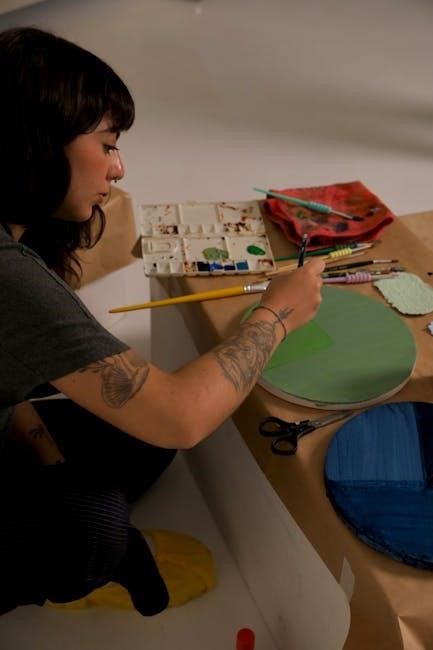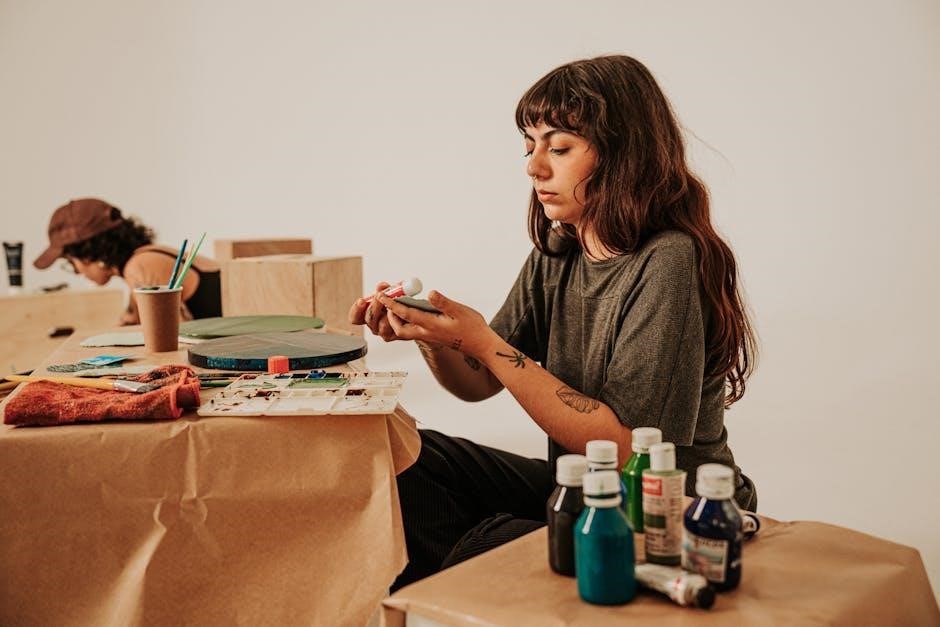Proper tattoo aftercare is essential for maintaining your tattoo’s appearance and health. This guide provides clear, practical instructions to ensure a smooth healing process and prevent complications.

Immediate Care After Getting a Tattoo
The first 24-48 hours are critical. Keep the tattoo wrapped, clean it gently with unscented soap, and apply a thin layer of recommended ointment like Aquaphor.
Keeping the Tattoo Wrapped
After getting your tattoo, it’s crucial to keep it wrapped for the first few hours to protect it from dirt and bacteria. Use the wrapping provided by your tattoo artist or a sterile, non-stick bandage. Leave it on for at least 2-3 hours, but no longer than 8-12 hours, as excessive wrapping can trap moisture and delay healing. Once removed, gently wash the tattoo with soap and apply a thin layer of ointment like Aquaphor. Avoid re-wrapping the tattoo unless instructed by your artist, as it can cause irritation or suffocate the skin. Proper wrapping ensures a clean environment for the tattoo to begin healing safely. Always follow your artist’s specific instructions for wrapping and aftercare.
Washing the Tattoo with Soap
Gently washing your tattoo with soap is a critical step in the healing process. Use a fragrance-free, antibacterial soap that’s designed for sensitive skin. Wet your hands, lather a small amount of soap, and gently massage it onto the tattoo using clean fingertips. Avoid scrubbing or applying too much pressure, as this can irritate the skin. Rinse thoroughly with lukewarm water to remove all soap residue. Pat dry with a clean, soft towel—never rub. Wash the tattoo 2-3 times daily to keep it clean and promote healing. Avoid using harsh soaps or body washes, as they can strip the skin of its natural oils and delay recovery. Always follow your artist’s recommendations for specific soap products. Proper cleansing helps prevent infection and ensures a smooth healing process.
Pat Dry the Tattoo
After washing, gently pat the tattoo dry with a clean, soft towel. Avoid rubbing or scrubbing, as this can irritate the skin and disrupt the healing process. Use a fresh, lint-free towel to prevent transferring bacteria or fibers to the tattoo. Pat dry thoroughly, ensuring no excess moisture remains, as this can lead to scabbing or prolonged healing. Avoid using hot water or harsh friction, which can cause discomfort and delay recovery. Always handle the tattoo with clean hands to minimize the risk of infection. Proper drying helps maintain a healthy environment for healing and prevents complications. Keep the tattoo dry between washings to avoid creating a breeding ground for bacteria. Gentle care is key during this sensitive phase.

Daily Care Routine
Maintain your tattoo’s health with a consistent daily routine. Cleanse gently, apply recommended ointments, and monitor for signs of infection. Keep the area moisturized to support healing.
Cleaning the Tattoo
Proper cleaning is crucial for tattoo aftercare. Gently wash the tattoo with mild, fragrance-free soap and lukewarm water. Avoid using harsh chemicals or abrasive scrubbers, as they can damage the skin. Use clean hands or a soft, non-abrasive cloth to cleanse the area. Rinse thoroughly to remove all soap residue. Pat dry with a clean towel—never rub, as this can irritate the tattoo. Cleaning should be done 2-3 times daily during the initial healing stages to prevent infection and promote a healthy environment for recovery. Always follow your tattoo artist’s specific recommendations for cleansing products and techniques.
Moisturizing the Tattoo
Moisturizing is a key step in tattoo aftercare to keep the skin hydrated and promote healing. Apply a thin layer of unscented, non-comedogenic lotion or ointment, such as Aquaphor or Cetaphil, 2-3 times daily. Avoid heavy or greasy products, as they can clog pores and slow healing; Gently rub the lotion into the tattoo until it’s fully absorbed. Over-moisturizing can lead to irritation, so use moderation. Always choose products recommended by your tattoo artist or those specifically designed for tattoo aftercare. Proper moisturizing helps prevent dryness, flaking, and fading, ensuring your tattoo heals vibrant and healthy. Keep the skin hydrated but not soaked, as excess moisture can create an environment for bacteria to grow. Regular moisturizing also reduces the risk of scabbing and irritation during the healing process.
Monitoring for Infection
Monitoring your tattoo for signs of infection is crucial during the healing process. Look for redness, swelling, or discharge around the tattooed area, which may indicate an infection. If you notice these symptoms, contact a healthcare professional immediately. Keep the tattoo clean and dry to prevent bacterial growth. Avoid touching the tattoo unnecessarily, as this can introduce germs; If you experience increased pain, warmth, or redness that doesn’t improve with proper care, seek medical attention. Early detection and treatment of infections can prevent serious complications and ensure proper healing. Regularly inspect the tattoo for any unusual changes and maintain good hygiene practices to minimize the risk of infection. Prompt action can make a significant difference in preserving the health and appearance of your tattoo.

What to Avoid During Healing
Avoid submerging the tattoo in water, wearing tight clothing, and using harsh chemicals. These can irritate the skin and delay healing. Follow aftercare instructions carefully.
Avoiding Submerging the Tattoo in Water
Avoiding submerging your new tattoo in water is crucial during the healing process. This includes swimming pools, hot tubs, lakes, and even long baths. Submerging the tattoo in water can introduce bacteria, leading to infections that can severely damage the tattoo. Instead, stick to short showers and gently clean the tattoo with mild soap. Avoid soaking the tattoo completely, as this can soften the scabs and delay healing. Use clean, damp cloths to wipe the area if needed. Keeping the tattoo dry prevents bacterial growth and promotes faster recovery. Always pat dry thoroughly after cleaning. By avoiding water submersion, you protect your tattoo from potential harm and ensure a smooth healing journey. Remember, proper care now means a vibrant, healthy tattoo later. Additionally, avoiding submerging the tattoo helps maintain the integrity of the ink and prevents fading. It’s essential to follow your tattoo artist’s specific advice, as they may have particular recommendations based on your tattoo’s design and placement. By being diligent and avoiding water submersion, you can ensure your tattoo heals properly and looks its best. Proper aftercare is an investment in your tattoo’s longevity and appearance.
Avoiding Tight Clothing
Avoiding tight clothing is essential to prevent irritation and promote healing of your new tattoo. Tight garments can rub against the tattoo, causing discomfort and potentially leading to complications like scabbing or delayed healing. Additionally, tight clothing can trap bacteria, increasing the risk of infection. Opt for loose, breathable fabrics such as cotton, which allow the skin to heal without interference. Avoid tight pants, shirts, or underwear that may press against the tattooed area. By giving your tattoo space to heal, you reduce the risk of irritation and ensure a smoother recovery. This simple precaution can make a significant difference in the overall health and appearance of your tattoo. Always prioritize comfort and hygiene during the healing process to achieve the best results. Loose clothing is a small but important step in proper tattoo aftercare.
Avoiding Harsh Chemicals
Avoiding harsh chemicals is crucial during the tattoo healing process, as they can irritate the skin and delay recovery. Products containing bleach, alcohol, or acidic ingredients should be avoided, as they can strip the skin of its natural moisture and potentially damage the tattoo. Instead, opt for gentle, fragrance-free cleansers specifically designed for tattoo aftercare. Harsh chemicals can disrupt the healing process, leading to dryness, scabbing, or even infection. Always read the ingredient labels and choose products recommended by your tattoo artist or healthcare professional. By steering clear of harsh chemicals, you protect the tattoo from unnecessary stress, ensuring a smoother and healthier recovery. This precaution helps maintain the tattoo’s vibrancy and prevents complications, allowing your skin to heal naturally and effectively. Proper care with gentle products is essential for achieving the best results.

Recommended Aftercare Products
For optimal healing, use products like Aquaphor Healing Ointment, Cetaphil Moisturizing Cream, and Neosporin to prevent infection. Natural alternatives can also be effective if recommended by your artist.
Aquaphor Healing Ointment
Aquaphor Healing Ointment is a highly recommended product for tattoo aftercare due to its ability to lock in moisture and promote healing. It’s fragrance-free and hypoallergenic, making it suitable for sensitive skin. Gently apply a thin layer 2-3 times daily to keep the tattoo hydrated and protect it from drying out. This ointment helps prevent scabbing and supports the skin’s natural repair process. Avoid applying too much, as it can create a thick barrier that may hinder healing. If you have allergies to petroleum-based products, consult your tattoo artist for alternatives. Aquaphor is widely available and trusted by professionals, making it an excellent choice for post-tattoo care. Regular use ensures your tattoo stays healthy and vibrant during recovery.
Cetaphil Moisturizing Cream
Cetaphil Moisturizing Cream is a popular choice for tattoo aftercare due to its gentle, non-greasy formula. It is fragrance-free and hypoallergenic, making it ideal for sensitive skin. This cream helps maintain moisture levels, preventing dryness and irritation during the healing process. Apply a thin layer 2-3 times daily, starting after the initial healing phase (usually 3-4 days post-tattoo). Cetaphil is dermatologist-recommended and suitable for long-term use. It supports the skin’s natural barrier function without clogging pores. While it is effective, it may not provide the same level of intense hydration as ointments like Aquaphor, so it’s best used for maintaining moisture rather than initial wound care. Consistency is key to ensure your tattoo heals smoothly and retains its vibrant appearance. Always follow your tattoo artist’s specific recommendations.
Neosporin for Preventing Infection
Neosporin is an antibiotic ointment commonly used to prevent infections in minor wounds, including new tattoos. Its active ingredients, neomycin and polymyxin B, effectively combat bacteria that could lead to infections. However, it’s crucial to use Neosporin sparingly and only during the initial healing phase. Overuse can cause skin irritation or allergic reactions, especially since some people are sensitive to neomycin. Apply a thin layer 1-2 times daily, but discontinue if you experience redness, itching, or rashes. Neosporin should not be used as a substitute for proper cleansing and moisturizing. Always patch test on a small area first and consult your tattoo artist if you notice any adverse reactions. While effective, alternatives like fragrance-free lotions are often recommended for ongoing care. Proper use of Neosporin can help safeguard your tattoo during its most vulnerable stage.
Natural Alternatives
Natural alternatives are increasingly popular for tattoo aftercare due to their gentle, chemical-free properties. Coconut oil, for instance, is known for its antibacterial effects and ability to keep the skin hydrated. Aloe vera gel is another excellent option, offering soothing and anti-inflammatory benefits. Shea butter is also used for its moisturizing properties, promoting skin elasticity and reducing the risk of scarring. When using natural products, ensure they are pure and unscented to avoid irritation. Always perform a patch test on a small area before applying to the tattoo. While natural alternatives can be effective, consult your tattoo artist to confirm they align with your specific aftercare needs. These options can provide a safer, more holistic approach to healing your tattoo without harsh chemicals.

Recognizing Complications
Early detection of complications is crucial for proper healing. Watch for signs like excessive redness, swelling, or scabbing, which may indicate infection or allergic reactions. Consult a professional immediately.
Signs of Infection
Signs of infection include increased redness, swelling, or warmth around the tattoo area. Pus or thick, yellowish discharge may appear, along with persistent itching or pain. Scabbing that becomes excessive or crusty can signal an issue. If you experience fever, chills, or red streaks spreading from the tattoo, seek medical attention immediately. These symptoms indicate a potential bacterial or fungal infection, which requires professional treatment. Proper hygiene and aftercare can prevent such complications, but early detection is key to avoiding severe outcomes. Always monitor your tattoo’s healing progress and consult a healthcare provider if you notice any unusual changes. Ignoring these signs can lead to serious health risks, including prolonged healing or permanent damage.
Allergic Reactions to Products
Allergic reactions to tattoo aftercare products can occur, causing discomfort and delaying healing. Common signs include redness, itching, or rashes around the tattoo area. Some individuals may react to ingredients in ointments or lotions, such as fragrances, dyes, or preservatives. If you notice any unusual irritation, discontinue use of the product immediately and switch to a fragrance-free, hypoallergenic alternative. In severe cases, blisters or swelling may develop, requiring medical attention. Always patch test new products on a small area of skin before applying them to your tattoo. If a reaction persists, consult your tattoo artist or healthcare provider for guidance. They may recommend alternative products or prescribe a topical treatment to alleviate symptoms. Preventing allergic reactions is crucial to ensure proper healing and avoid further complications.

Promoting Healing
Proper nutrition, staying hydrated, and protecting the tattoo from UV exposure are key to promoting healing. A healthy diet rich in vitamins helps maintain skin integrity and supports recovery.
Proper Nutrition
A balanced diet rich in vitamins, minerals, and proteins is crucial for optimal tattoo healing. Include foods high in vitamins A, C, and E, such as fruits, vegetables, and nuts, to support skin health. Lean meats, fish, and eggs provide essential proteins for tissue repair. Omega-3 fatty acids from sources like salmon and flaxseeds can reduce inflammation. Whole grains and complex carbohydrates offer sustained energy for recovery. Stay hydrated by drinking plenty of water to keep your skin hydrated and promote healing. Avoid excessive sugar and alcohol, as they can hinder the immune system and slow recovery. A nutritious diet ensures your body has the resources needed to heal efficiently and maintain the vibrancy of your tattoo.
Hydration
Staying hydrated is vital for proper skin health and tattoo healing. Drinking plenty of water ensures your skin remains moisturized from the inside out, promoting faster recovery. Aim to drink at least 8-10 glasses of water daily to help your body flush out toxins and deliver essential nutrients to the healing tattoo. Proper hydration also supports the immune system, reducing the risk of infection. Avoid excessive alcohol and caffeine, as they can dehydrate your body and slow the healing process. Keep a water bottle handy and sip throughout the day to maintain optimal hydration levels. This simple yet effective practice will help your tattoo heal smoothly and maintain its vibrant appearance.
Sun Protection
Protecting your tattoo from the sun is crucial during the healing process and beyond. UV rays can cause fading, blistering, and prolonged healing. Always use a broad-spectrum sunscreen with SPF 30 or higher when exposed to sunlight, even after the tattoo has healed. Apply sunscreen 15-30 minutes before sun exposure and reapply every two hours or after swimming. Wearing protective clothing, such as long sleeves or a hat, can also shield your tattoo from harmful rays. Avoid direct sunlight during peak hours (10 AM–4 PM) to minimize damage. Sun protection not only preserves the vibrancy of your tattoo but also prevents skin damage and promotes long-term health. By prioritizing sun care, you ensure your tattoo remains vibrant and intact for years to come.

Frequently Asked Questions
How long does a tattoo take to heal? Healing typically takes 2-4 weeks, but full recovery can take several months. Can I exercise with a new tattoo? Avoid strenuous activities until healed. Is scabbing normal? Yes, but avoid picking scabs to prevent damage.
How Long Until the Tattoo Heals?
The healing process for a tattoo typically takes 2 to 4 weeks for the initial phase, during which the skin repairs itself and the tattoo begins to settle. However, full recovery and complete healing can take several months, as the deeper layers of skin continue to regenerate. Factors like tattoo size, location, and aftercare routines can influence the healing timeline. It’s important to follow your artist’s instructions closely to ensure proper healing and avoid complications. Keep in mind that the tattoo may appear fully healed before it actually is, so patience is key. Signs of healing include peeling, scabbing, and a smooth, even texture. Always monitor for infections and maintain consistent aftercare to support the healing process.
Can I Exercise with a New Tattoo?
Exercising with a new tattoo requires caution to avoid complications. For the first two weeks, it’s best to avoid strenuous activities, as sweat and friction can irritate the tattoo and slow healing. Activities like running, cycling, or weightlifting can introduce bacteria and cause friction, increasing the risk of infection. If you must exercise, keep the tattoo clean and moisturized afterward. Avoid tight clothing that may rub against the tattoo, as this can cause irritation or scabbing. Light stretching or low-impact exercises, like yoga, may be acceptable if done carefully. Always prioritize your tattoo’s health and wait until it’s fully healed before resuming intense workouts. Proper hygiene and aftercare are essential to ensure your tattoo heals smoothly and retains its vibrant appearance.
Is It Normal for the Tattoo to Scab?
Scabbing is a natural part of the tattoo healing process, as your skin works to repair itself. A thin layer of scabbing or peeling is typically normal, especially during the first week. However, excessive scabbing or thick, dark scabs may indicate improper aftercare or irritation. To care for scabs, gently wash the tattoo with soap and lukewarm water, then pat it dry. Avoid picking or scratching, as this can lead to infection or permanent damage. If scabs are unusually large, painful, or accompanied by redness and swelling, consult your tattoo artist or a healthcare professional. Proper care ensures scabs heal evenly and your tattoo retains its vibrancy. Always follow your artist’s specific advice to promote smooth healing.

Printable Tattoo Aftercare Checklist
Use this checklist to ensure proper care for your new tattoo:
– Keep the tattoo wrapped for the first 24 hours as instructed by your artist.
– Wash the tattoo with lukewarm water and mild soap 2-3 times daily.
– Pat dry with a clean towel; avoid rubbing.
– Apply a thin layer of recommended ointment or lotion (e.g., Aquaphor or Cetaphil).
– Monitor for signs of infection (redness, swelling, pus, or increased pain).
– Avoid submerging the tattoo in water (baths, pools, or hot tubs) until healed.
– Wear loose, clean clothing to prevent irritation.
– Keep hands clean before touching the tattoo.
– Stay hydrated and maintain a balanced diet to promote healing.
– Avoid direct sunlight until the tattoo is fully healed.
Check off each task daily to stay on track and ensure proper healing. Always follow your tattoo artist’s specific advice for the best results.
Proper tattoo aftercare is crucial for ensuring your tattoo heals well and retains its vibrant appearance. By following the steps outlined in this guide, you can minimize the risk of complications and promote a smooth recovery. Remember to keep your tattoo clean, moisturized, and protected from harmful elements like direct sunlight and harsh chemicals. Always prioritize your tattoo artist’s advice, as they may have specific recommendations tailored to your needs.
Download and use the printable checklist provided to stay organized and ensure consistency in your care routine. With patience and dedication, your tattoo will heal beautifully, becoming a lasting piece of body art you can cherish for years to come.

Additional Resources
For further guidance, explore trusted aftercare guides and expert articles that offer detailed tips and product recommendations to support your tattoo healing journey effectively.
Links to Trusted Aftercare Guides
For comprehensive tattoo aftercare information, visit Tattoo Artist’s Aftercare Guide or Tattoo Healing Tips. These resources provide expert advice on cleaning, moisturizing, and preventing infections. Additionally, check out All About Tattoos for printable checklists and product reviews. Ensure your tattoo heals optimally by following these trusted guidelines.
Further Reading
For deeper insights into tattoo aftercare, explore books like The Tattoo Healing Handbook or online articles such as Advanced Aftercare Techniques. These resources delve into the science behind tattoo healing and offer expert tips for optimal care. Additionally, websites like Tattoo Aftercare Pro provide in-depth guides tailored to different skin types and tattoo styles. You can also find detailed aftercare instructions on platforms like Google Scholar or academic databases for a more research-driven approach. Lastly, join online forums or communities dedicated to tattoos to share experiences and learn from others who have gone through the healing process. These resources will help you make informed decisions and ensure your tattoo heals flawlessly.